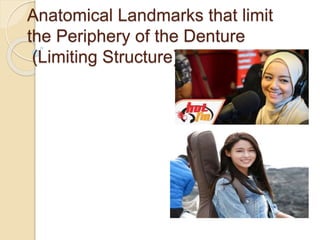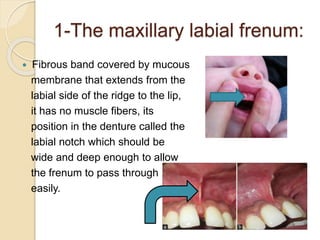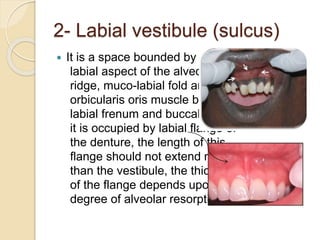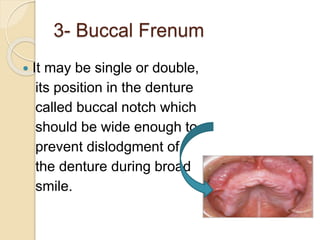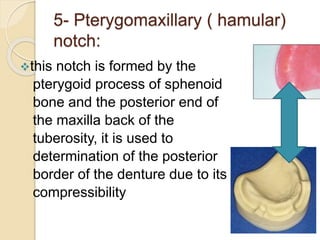Limiting structure presentation
- 1. Anatomical Landmarks that limit the Periphery of the Denture (Limiting Structure)
- 2. In relation to Maxillary Denture ’éŚ Labial Frenum ’éŚ Labial Vestibule ’éŚ Buccal Frenum ’éŚ Buccal Vestibule ’éŚ Ptergomaxillary (Hamular) notch ’éŚ Vibrating line of Palate
- 3. 1-The maxillary labial frenum: ’éŚ Fibrous band covered by mucous membrane that extends from the labial side of the ridge to the lip, it has no muscle fibers, its position in the denture called the labial notch which should be wide and deep enough to allow the frenum to pass through easily.
- 4. 2- Labial vestibule (sulcus) ’éŚ It is a space bounded by the labial aspect of the alveolar ridge, muco-labial fold and orbicularis oris muscle between labial frenum and buccal frenum, it is occupied by labial flange of the denture, the length of this flange should not extend more than the vestibule, the thickness of the flange depends upon the degree of alveolar resorption.
- 5. 3- Buccal Frenum ’éŚ It may be single or double, its position in the denture called buccal notch which should be wide enough to prevent dislodgment of the denture during broad smile.
- 6. 4- Buccal vestibule ’éŚ It is a space posterior to buccal frenum and extend to hamular notch, it houses buccal flange of the denture, the thickness of the buccal flange of the denture must not be thick to avoids coronoid process of the mandibule, the zygomatic process often needs relief.
- 7. 5- Pterygomaxillary ( hamular) notch: ’üČthis notch is formed by the pterygoid process of sphenoid bone and the posterior end of the maxilla back of the tuberosity, it is used to determination of the posterior border of the denture due to its compressibility
- 8. 6-Vibrating line of the palate ’ü▒It is imaginary line drawn across the posterior part of the palate that marks the beginning of vibrating in the soft palate when the patient says ( ŌĆ”ahhhhh ), it extends from one pterygomaxillary notch to the other, it is always on the soft palate.
- 9. The end ’üŖ

